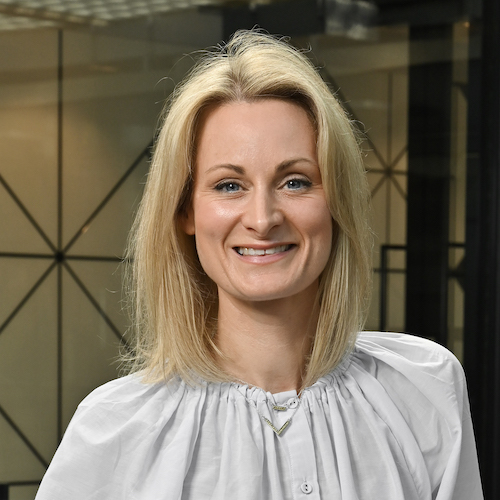The thought leadership advantage: Elevating Intrum’s brand in a competitive market
Emily Taylor Gregory
In a detailed discussion about brand-building at Intrum, Europe’s leading credit management company, thought leadership emerges as a pivotal component of its brand strategy.
Marte Gran Kristoffersen, Global Content, Insights and Web Director at Intrum, heads up the company’s thought leadership programme. In this interview, she highlights the company’s commitment to thought leadership and explains its necessity in maintaining Intrum’s authoritative stance in the industry; achieved through sharing intelligence and insights on late payments and non-payments with its clients and the broader market.
We dig deep into why Intrum’s approach to thought leadership is multifaceted, incorporating longstanding tools such as the European Payment Report and the European Consumer Payment Report, which have been instrumental since 1998. And we learn about why the company’s strategy of balancing consistency with adaptability, particularly in engaging with media through sustained relationships and timely, seasonal content, enables the business to keep its thought leadership fresh and impactful. We also hear why a critical aspect of Intrum’s strategy includes the delicate balance between presenting a strong point of view and maintaining neutrality, ensuring credibility and relevance across Pan-European and local markets.
The conversation delves into the impact of Intrum’s insights programme with its diverse audience, from policymakers to the general public, emphasising the role of thought leadership in corporate affairs and policy discussions; and the importance of involving senior leadership in thought leadership planning, advocating for early involvement to shape narratives and make content more relatable, and so maximising the impact and reach of their initiatives across the organisation.
Watch the full interview here to get the low-down here:
This exclusive Q&A is part of a series of conversations with high-profile marketers and communicators about what it takes to produce real thought leadership – from campaign strategy to content activation.
Transcript:
Rob Mitchell: Hello, and welcome to the first in a series of videos from FT Longitude in which we speak with marketing communications leaders about their experiences of using thought leadership to build their brand and add value to their organisation. My name’s Rob Mitchell, and I’m the co-founder and CEO of FT Longitude, a specialist thought leadership business that’s part of the Financial Times Group. I’m delighted to welcome to the studio Marte Gran Kristoffersen, who is global content, insights and web director at Intrum. Welcome Marta, and thanks very much for joining me today.
Marte Gran Kristoffersen: Many thanks for the invitation.
Rob Mitchell: So perhaps we could start the conversation by… In fact, you could introducing Intrum and give us a sense of what the business is all about, and also the role that thought leadership plays in the organisation.
Marte Gran Kristoffersen: Absolutely. So Intrum is Europe’s leading credit management company. We are 10,000 employees across 20 markets, and what we do every day is to work for sound economy. What this means is that we help companies to get paid for services and goods that they have already sold, and we help people come out of debt. So every day, we speak to 250,000 people in debt and help them get back on financial track. So that’s what we do, and being the market leader, our clients also look for us and expect us to share trends, the developments about late payments and non-payments, and that’s why thought leadership is crucial in our brand strategy.
Rob Mitchell: And what role does thought leadership play in the organisation? Is it all about the brand or does it perform other functions as well?
Marte Gran Kristoffersen: Well, we use it across the board really. The thought leadership provides credibility and authority in our industry and helps us to position Intrum as the expert, so we use it both for commercial dialogues together with clients and potential clients. We use it actively towards media and PR activities, both pan-European, international and local. And we also use it quite extensively when it comes to our public affairs agenda.
Rob Mitchell: And there are two main thought leadership properties at Intrum. Could you perhaps describe a little bit about what those two properties are?
Marte Gran Kristoffersen: Yeah, absolutely. We have a great legacy of providing thought leadership to the market. We have two concepts that our communications are built on, and that’s the European Payment Report and the European Consumer Payment Report. We have a rather long-term strategy for providing insights to our stakeholders, so the EPR, the payment report goes back to 1998, so it has a great legacy for us positioning and sharing insights about late payments.
Rob Mitchell: So it’s interesting that you’ve had these reports running for such a long time. What have been some of the challenges of maintaining freshness with such a longstanding and well-established report, while at the same time, benefiting from that legacy?
Marte Gran Kristoffersen: Well, that is very difficult indeed. I think it’s important for us to keep the consistency of providing insights on a regular basis, because it gives us the opportunity to be top of mind with the stakeholders that we talk to. We always make sure that we go back to the basics on what is actually the concepts all about, so we go back to that it’s all about late payment and what comes naturally to us to talk about, so we need to keep consistency in order to provide historical data points on the most important aspects that we report on. But the world changes so fast these days that we need to make sure that we’re also on trends, that we try to look outside for market trends, what is happening externally in the macroeconomic environment in order to stay fresh, and also to provide our clients and other stakeholders with insights on the outlook for the future.
Rob Mitchell: And one of the key audience for this is the media, as you mentioned, notoriously difficult audience to engage. So how do you keep it fresh for journalists and keep the media stories fresh when the research has been going for such a long time? I suppose on the one hand, it’s good they look forward to it, they know it’s coming, but how do you keep it fresh for them, for the media?
Marte Gran Kristoffersen: Yeah, it’s all about relationships, isn’t it? So we work very actively in providing these insights on a regular basis and continue the dialogue together with the journalists of the top tier magazines and trade magazines that we’re targeting. For us, it’s important that we also monitor what’s going out externally so that what we investigate and what we analyse also makes sense in the future and can provide them with seasonal topics, Black Friday, Christmas, anything that comes down to impacting people’s household finances. So we try to look for that in the content calendar as well to make sure that our insights are also seasonally and timely.
Rob Mitchell: So Marta, you talked a bit about the role that thought leadership plays in brand and media and the commercial side of the business as well. What about the corporate affairs angle? Is that an important goal as well?
Marte Gran Kristoffersen:It is. It’s very important for us being the market leader and expert to provide that insights also to other stakeholders, NGOs and policymakers. And based on the reports that we publish, we are invited in to speak to European commissions and other local authorities as well on how this develops. So that is naturally a very important area for us to be visible in, to be part of those dialogues and be part of shaping the conversations when it comes to late payments. So we work quite actively with it. We invite them to be part of developing the content, to be part of developing the narrative and have broader discussions, so definitely something we work quite much with.
Rob Mitchell: So how important is it for Intrum to have a point of view on the topics that you talk about in your thought leadership? Or is it more important to have a neutral tone of voice?
Marte Gran Kristoffersen: I think both. Naturally, Intrum has a kind of position point of view. It is our voice and we need to make sure that the insights that we provide is credible and reliable, but also the neutral part is important for us to make sure that we can back up the insights and the results that we provide to the market. So both with having neutral partners supporting us with the concepts, like you in Longitude, but also backing up with external data from the ECB, Eurostat and other external data points to make sure that what we see on our side is also reflected in other surveys. That really strengthens the thought leadership agenda that we have, and then we can rather pinpoint and comment on the advice that we have for clients and corporates on moving ahead and navigating in the challenges.
Rob Mitchell: So that data gives you a platform that you can build an opinion around, but you’ve got that central platform that provides the foundation working with partners like FT Longitude or third parties as well.
Marte Gran Kristoffersen: Exactly, and that’s really the strength of the concept as well, that is not only based on our internal data. It’s also based on neutral research that we have created together with partners.
Rob Mitchell: Great. And another characteristic of your thought leadership is you need to satisfy a pan-European audience, but at the same time, local audiences within each market. How do you strike the balance between that global or regional focus, if you like, and the more local focus within market?
Marte Gran Kristoffersen: Well, we make sure that we have a couple of central teams and insights that we can measure across the board and provide this pan-European perspective, so that our CEO can take the international stage, but we also get input from our local marketing and brand and sales colleagues to ensure that the insights that we provide on a local level is also very relevant for that specific market. Europe is a big market in that sense and it differs so much on what is relevant in the South compared to the north, and the maturity is also so different. So we need that input from our local colleagues in order to ensure that we have relevant insights benefiting all.
Rob Mitchell: I think it is an issue that many of our clients we work with struggle. It’s the same thing. It’s that balance between global and local and having the large property at the centre that delivers so much of the value, but at the same time, ensuring that the markets have insights that they can own themselves.
Marte Gran Kristoffersen: Yeah, and that’s crucial for us. We work with it very actively, positioning global senior managers and spokesperson towards the international media, looking at the broad picture of Europe, but then also equipping senior managers on the local level with local insights. You care about what your neighbours do and what goes on in your backyard, so local insights is super crucial for us to provide, both to PR and media, but also to clients, because our business is local.
Rob Mitchell: Especially with the sort of topics that you are covering, as you say, is very, very market-specific in many ways. Another thing that a lot of our clients struggle with and find difficult is engaging senior leaders in their thought leadership, and I think you do a great job of this and you have the senior leadership at Intrum is very visible taking this to market. How do you work with your senior leadership team and ensure that they amplify this and that you collectively get the most impact from the work that you do?
Marte Gran Kristoffersen: We have a quite extensive spokesperson strategy, ensuring that the people that we put on front is on the core on what they should also be talking about externally. We make sure that insights is also relatable to the role that they have at Intrum, so that they both privately and professionally have something to bring to the table and also that fits naturally with the relevance and the work that they do for Intrum. So that’s very important for us, that we have something to provide them that are close to their heart as well and that they find meaningful to talk about, and household economies and people’s everyday life and how we can help our clients to get back on track is very dear to many of those that we position.
And then very practical, what we have also learned down the years is that everything, all good things are three, so we try to put everything in number three. Top three data points that our CEO should know about, top three trends, top three teams, everything is top three because that’s very easy to learn, and then we see that the engagement and the usage of the insights also is broader.
Rob Mitchell: What advice would you have for companies that are perhaps struggling to get their senior leadership on board with the thought leadership? And we talked about some of those areas there, but are there any specific tips that you would recommend that they follow?
Marte Gran Kristoffersen: Yeah, involve them early, already from the beginning if possible, so that they can be part of shaping the narrative, the analysis if it’s based on the survey that they give input on the questions. Because there might be conversations that they have where they don’t have backup data, and we can provide that so that they can use that insights and also have great conversations with the people that they talk to, so that’s important.
Rob Mitchell: Great insights and a fascinating perspective. Many thanks for joining us, Marta. That’s all we’ve got time for today. We’ll be sharing fresh perspectives from marketing and communications leaders in the months ahead. In the meantime, subscribe to receive our insights on our website at longitude.ft.com/subscribe.
Speak to the team
We’ll help you to navigate and overcome any challenges you currently face and learn how to get more out of your content.
Book a meeting
About the author: Emily Taylor Gregory
Emily is our marketing director, responsible for the brand, marketing and communications strategies for FT Longitude. Emily leads our content and events programmes, as well as our speaking engagements and PR activity, working closely with our editorial and research teams to develop and promote insight and best practice at the cutting edge of thought leadership.
Before joining FT Longitude, Emily spent 14 years working in various marketing roles in the publishing and technology sectors.
 |
Tel:
+44 (0)20 7873 4770
|
Tel:
+44 (0)20 7873 4770


